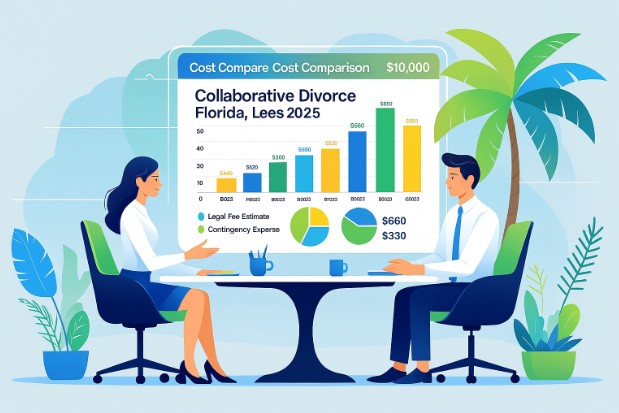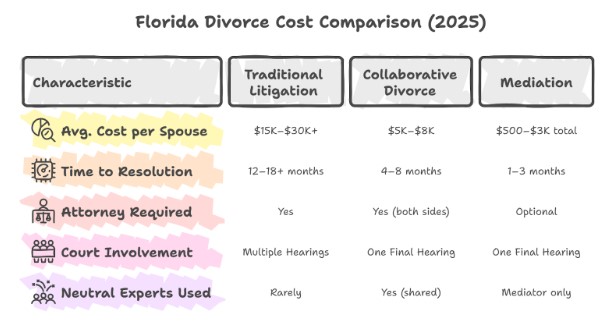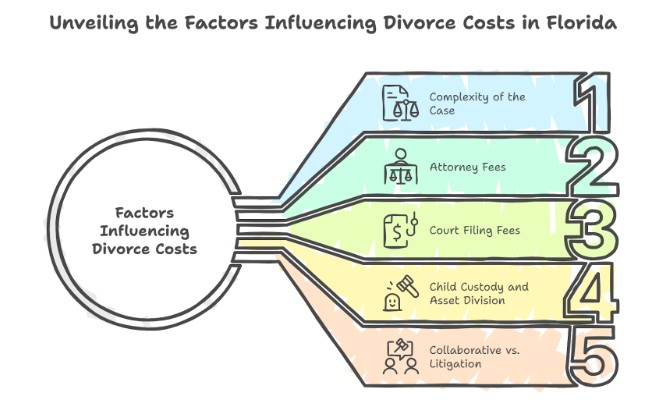Collaborative Divorce Cost Comparison in Florida (2025) – Analyzing Fees and Savings Options
Originally published: August 2025 | Reviewed by Carol Ann Mazza

Collaborative divorce is becoming a popular option in Florida for couples seeking to avoid lengthy court battles and high legal fees.
Unlike traditional litigation, it’s a more cooperative approach where spouses and their attorneys work together toward agreements. This method usually leads to a faster and less stressful divorce process.
In 2025, collaborative divorce in Florida typically costs less than courtroom litigation, as it reduces legal fees and court expenses.
Couples can save a significant amount of money by sharing a neutral professional, such as a financial advisor. The entire process feels more streamlined, so you’re not wasting hours of billable time.
Understanding the cost differences between collaborative divorce and other options in Florida can help couples make more informed decisions about their divorce.
Since costs vary based on the complexity of the situation, understanding the basics can help you achieve a more affordable and less contentious split.
Key Takeaways
- Collaborative divorce in Florida averages $5,000–$8,000 per spouse, far less than traditional litigation.
- Mediation is often the most cost-effective option, but it may not be ideal for complex or emotionally charged cases.
- Shared professionals in collaborative divorce help reduce costs and conflict.
- Budgeting early helps Florida families stay in control of the process and avoid financial surprises.
Average Divorce Costs In Florida (2025 Data)

Divorce costs in Florida can swing wildly depending on which process you pick. Complexity, the amount you own, and whether you have children all play a role in the final bill.
Filing fees, attorney charges, and additional services vary depending on the type of divorce.
Traditional Divorce (Litigation)
Litigation is usually the most expensive route—the average cost ranges between $8,000 and $15,000 or more per person.
You’ll pay for attorneys, court hearings, and maybe even expert witnesses. Filing fees range from $400 to $410, and the additional cost for summons/service of process is $50 to $60.
Costs jump higher if you’re fighting over assets or custody. Legal battles can drag out timelines, resulting in even higher fees.
Anyone choosing this path should be prepared for unpredictable legal bills, especially if the case becomes complicated.
Some highly contested cases can blow past those initial numbers. You can check out more details at divorceinfloridaonline.com.
Collaborative Divorce
Collaborative divorce in Florida typically ranges from $7,500 to $15,000 per person, depending on the specific circumstances. Both sides work with specially trained attorneys and sometimes bring in financial or mental health experts, all of whom are outside the courtroom.
The big draw? You skip the endless court battles and save money. Approximately 30% of collaborative divorces are finalized for under $25,000 in total, and most don’t exceed $50,000.
It depends on how tangled your issues are. This process emphasizes cooperation, which can help alleviate emotional stress and keep legal fees in check.
Collaborative professionals typically handle most disputes through negotiation, providing a clearer sense of costs. You’ll find more comparisons at sampsoncollaborativelaw.com.
Mediation
Mediation is often the most cost-effective option, and Florida courts encourage it, particularly when children are involved. Typical mediation costs range from $2,000 to $5,000, depending on how many sessions you need.
If you have children, the court requires you to complete a parenting course, which incurs a small but unavoidable fee. Mediation typically charges by the hour, with rates ranging from $150 to $300 per hour.
This route focuses on reaching agreements with a neutral third party, often making it faster and cheaper than litigation or collaborative divorce.
CollaborativeNow helps you avoid the financial stress of traditional divorce. Our collaborative divorce process offers transparency and control. Contact us to schedule your cost consultation today.
If you’re ready to get started, call us now!
Florida Divorce Cost Comparison Table

Divorce costs in Florida shift depending on the process. Collaborative divorce and mediation are often more cost-effective than litigation; however, prices can still vary significantly depending on the complexity and attorney fees.
Here’s a quick table comparing typical costs for Florida divorces in 2025:
| Divorce Type | Avg. Cost per Spouse | Time to Resolution | Attorney Required | Court Involvement | Neutral Experts Used |
| Traditional Litigation | $15K–$30K+ | 12–18+ months | Yes | Multiple Hearings | Rarely |
| Collaborative Divorce | $5K–$8K | 4–8 months | Yes (both sides) | One Final Hearing | Yes (shared) |
| Mediation | $500–$3K total | 1–3 months | Optional | One Final Hearing | Mediator only |
Collaborative divorce costs typically include the services of attorneys, divorce coaches, and financial advisors. The level of cooperation between both sides makes a significant difference in the final bill.
Mediation is often less expensive but may require several sessions, depending on the complexity of the issue at stake. Parents are also required to complete a mandatory parenting course if they have children.
Litigation typically incurs the highest costs, as it consumes a significant amount of attorney time and requires numerous court appearances. Attorney rates can climb if you hire experienced lawyers.
What’s Included In Each Divorce Method?
Each divorce method comes with its steps and professionals. Costs depend on the services you utilize, including those of lawyers, mediators, and other experts.
Knowing what’s covered in each method helps you see where your money goes.
Litigation
Litigation is the traditional path. Each spouse hires a family law attorney to handle all legal filings, court appearances, and negotiations on their behalf.
Lawyers gather evidence, file motions, and present cases in court. Court hearings determine matters such as child custody, support, alimony, and property division.
Typically, this process involves multiple court dates and numerous formal steps, resulting in a longer duration and higher costs.
You may need to bring in experts, such as financial advisors or child specialists, for reports or testimony, which can increase the price.
The entire approach is adversarial—everyone is trying to “win” through legal maneuvering instead of working together. That usually leads to higher fees and more stress as conflicts drag on.
Collaborative Divorce
Collaborative divorce is all about cooperation. Both parties and their attorneys agree to settle things outside of court, starting with a participation agreement that says everyone will communicate openly.
This process often involves a team, perhaps a divorce coach, financial advisors, or child specialists. These neutral professionals help guide discussions on parenting plans, custody, and economic matters.
The focus is on solutions that work for both people and support long-term co-parenting. Kids’ needs tend to get more attention with this team approach.
Costs are more predictable since you don’t have to keep showing up in court. The process relies on problem-solving and transparency, resulting in lower legal fees compared to litigation.
Mediation
Mediation utilizes a neutral mediator to help couples reach mutually agreeable agreements. The mediator doesn’t take sides or make decisions—they simply facilitate the discussion on issues such as alimony, child support, and co-parenting.
Unlike collaborative divorce, you might not have an attorney in the room during mediation. The mediator helps break down problems and encourages compromise.
Mediation is usually faster and less expensive because you don’t need as many professionals or any court time. The couple maintains control over decisions, which can help reduce conflict and stress.
If you’re willing to discuss things but need a neutral party to guide the conversation, mediation can be a beneficial option. Costs are typically on the lower end, depending on session length and mediator rates.
Key Factors That Influence Divorce Costs In Florida

Several factors shape divorce costs in Florida. The complexity of the case matters most—child custody and dividing assets can significantly increase the price.
Simple, uncontested divorces are typically less expensive than contested ones. Filing fees and court costs are standard, but legal fees for divorce lawyers can be all over the map, depending on the attorney’s experience and workload.
The Florida Collaborative Law Process Act encourages couples to try the collaborative law process. This route usually lowers costs by reducing court involvement.
Couples and their attorneys collaborate to reach agreements without resorting to litigation. Still, bringing in extra professionals, such as financial advisors or counselors, can increase expenses.
If the divorce is contested, expect a more lengthy and expensive process. Collaborative divorce, thanks to the Florida Collaborative Law Process Act, often saves money by sidestepping these drawn-out disputes.
- Attorney fees
- Court filing fees
- How complicated child custody and asset division are
- Whether you go collaborative or stick with litigation
Understanding these factors helps you estimate divorce costs in Florida and choose the most suitable approach for your situation.
Thinking about family mediation? CollaborativeNow helps Florida families resolve disputes efficiently and affordably. Let’s discuss what fits your situation best—schedule a time to connect.
If you’re ready to get started, call us now!
Why Collaborative Divorce May Save You More (Long-Term)
Collaborative divorce usually costs less than traditional litigation over time. Since it encourages cooperation, couples often reach an agreement more quickly.
That shorter timeline can mean lower legal fees and fewer extra costs from drawn-out court battles. It’s not always a magic fix, but the numbers often look better in the end.
When you bring in a collaborative divorce attorney, you get help finding solutions without stepping into a courtroom. These attorneys guide both parties, aiming for respectful and private discussions.
This approach avoids expensive and stressful court disputes. It’s not perfect, but it can keep things calmer for everyone involved.
The process aims to be a more cost-effective divorce option. Couples keep more control and work toward mutually agreed-upon terms.
Most of the time, this leads to fewer appeals or future conflicts, so you’re not paying for the same fight twice. That’s a relief, right?
Collaborative divorce also supports a more peaceful divorce experience. The focus stays on open communication and problem-solving.
This can reduce emotional strain and help protect family relationships, especially if you’ve got kids in the mix.
Here’s a quick comparison of costs:
| Factor | Collaborative Divorce | Traditional Divorce |
| Legal Fees | Generally lower due to shorter timeline | Can escalate with court hearings |
| Court Costs | Minimal or none | Often significant |
| Emotional Costs | Lower due to cooperation | Often higher due to conflict |
| Time to Resolution | Faster, weeks to months | Can take years |
If you want an efficient, respectful, and financially savvy way to end a marriage in Florida, collaborative divorce is a viable option worth considering.
Realistic Budgeting Tips For Florida Families
If you’re a Florida couple starting a collaborative divorce, list every possible expense you can think of. Legal fees, mediation costs, court filing fees—all of it adds up.
Knowing these numbers ahead of time makes budgeting a lot less overwhelming. No one likes nasty surprises.
Consider using a fixed-fee structure if possible. This allows families to pay a set amount for specific services instead of paying hourly rates.
It’s more predictable and helps avoid those “how did it get so expensive?” moments. Not a bad trade-off for some peace of mind.
Mediation or collaborative divorce can also help you save money. These options usually cost less than traditional litigation because you skip the endless court battles.
That means you can protect more of your financial resources for whatever comes next.
Don’t forget about hidden expenses. Fees for financial advisors, child specialists, or document prep can sneak up on you.
Setting aside a small emergency fund can make those surprises less painful. It’s not fun, but it’s practical.
Here’s a simple budget checklist for Florida families:
- Legal fees
- Mediation costs
- Court filing fees
- Expert consultations
- Miscellaneous expenses
Review this list periodically and adjust your spending as needed. It’s easy to slip into overspending or debt if you don’t keep a close eye on your finances.
Florida families should also look into unbundled legal services. This way, you only pay for the legal help you need, not the whole package.
It’s a smart move for keeping costs manageable while still getting solid advice. Good budgeting doesn’t solve everything, but it sure makes the transition a little smoother—and who wouldn’t want less financial stress during divorce?
Conclusion
Collaborative divorce in Florida typically provides individuals with a clear financial advantage over traditional litigation.
Most people end up paying between $7,500 and $15,000 each, although this amount can vary depending on the assets and parenting issues involved.
Traditional divorce, especially when kids are in the mix, can shoot past $20,000 pretty easily. That’s a significant difference for many families.
The collaborative process leans on cooperation and open communication. You’ll probably spend less time in court, which means fewer legal fees and, honestly, a lot less stress.
However, the final cost ultimately depends on how complicated things become and which professionals you engage. Always review the agreements carefully before signing anything.
Florida law governs collaborative divorce, so you’ll need signed agreements and, often, neutral experts to help out. This structured approach aims for fairness while keeping expenses in check.
If you’re seeking a less adversarial and more budget-friendly option, collaborative divorce in Florida may be the ideal solution.
Don’t let unexpected legal bills derail your divorce. CollaborativeNow offers cost-conscious divorce mediation solutions built around your needs. Contact us today to start your personalized plan.
Contact Us Today For An Appointment
Frequently Asked Questions
How much does collaborative divorce cost in Florida in 2025?
Collaborative divorce in Florida typically costs $5,000 to $8,000 per spouse. This includes attorney fees and shared neutral professionals, making it more affordable than litigation, which often exceeds $15,000 per person.
Is collaborative divorce more affordable than traditional divorce in Florida?
Yes. Traditional litigation in Florida often costs two to three times more due to court appearances, delays, and adversarial proceedings. Collaborative divorce reduces the need for legal hours and avoids costly hearings.
Why is collaborative divorce less expensive than litigation?
Because collaborative divorce avoids multiple court hearings and utilizes shared experts, it minimizes attorney fees and duplication of services, resulting in lower overall costs and faster resolutions.
What’s included in the cost of collaborative divorce?
Costs typically cover two attorneys, a financial neutral, and a mental health professional. These experts help resolve financial, parenting, and emotional matters out of court.
Can collaborative divorce in Florida be done on a flat fee?
Some Florida attorneys and professionals offer flat-fee or phased pricing for collaborative divorce. Always ask about billing options during your initial consultation.
Does child custody or property division affect the cost?
Yes. High-conflict custody issues, business valuation, or complex assets may increase the number of sessions and professionals required, potentially resulting in a total cost that exceeds average estimates.
